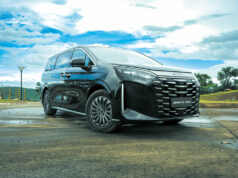By Kap Maceda Aguila
LEXUS Philippines last week took the wraps off the new-generation ES, which successfully debuted on the world stage at the Beijing Motor Show in April. Since its first appearance in 1989 as a compact luxury sedan, the ES has cycled through seven generations while growing into the midsize automobile that it is today.
In a speech delivered at the brand’s sole Philippine dealership (at the Bonifacio Global City), Toyota Motor Philippines president Satoru Suzuki described the ES as a “reborn executive sedan that has been transformed from the sixth generation,” and called it a “core model in the Lexus lineup, being just one of two vehicles [the other is the LS flagship] that have been part of the brand since its beginnings.”
After the RX, the ES is the brand’s most popular model with over 2.18 million units sold globally, and this new generation will be sold in over 90 countries, revealed Yukihiro Kito, deputy chief engineer of the ES, who attended the car’s reveal.
According to a statement by Lexus Asia Pacific vice-president David Nordstrom; “Traditional customers will find the all-new ES more spacious, quieter and safer, while new customers will be drawn to its bolder styling, sharpened performance, advanced technologies, unique cabin materials, and unmatched craftsmanship.”
Priced at P4.308 million for its lone available variant here (the ES 350), the sedan boasts a sleek and dynamic exterior — highlighted by a sharper interpretation of the brand’s iconic spindle grille. Lower, wider and longer that the outgoing ES, the seventh generation rises on a new platform and is equipped with an improved suspension system to “provide more dynamic handling with intuitive responsiveness.”
A carryover 3.5-liter, direct-injection V6 puts out 300 hp and 355 Nm. Notably, though, Lexus has tweaked the power plant with an Atkinson cycle ability. “It’s technology that controls the cylinders to regulate cylinder usage — preventing the unnecessary opening of cylinders and overfeeding the engine with gas. It helps with fuel economy. We have data that show the engine is 8-12% more fuel-efficient,” said Lexus Philippines product planner Jovie Roqueza to BusinessWorld.
Mr. Roqueza continued that the ES is a direct result of what Lexus knows about the people who buy the car. “We know our customers, and we can see that they are 100% chauffeured, although they like to drive it on the weekend,” he said. “We focused on rear-seat comfort [and] one of the things we added was a recline for the second row; it can power-recline up to eight degrees. Before, it couldn’t recline at all.”
And also because ES owners spend a lot of time ensconced in the rear, Lexus engineers have redesigned the second row for enhanced comfort. “They now feature widened headrests and improved contouring for better ergonomics,” added the product planner.
The Japanese premium car maker is also cognizant of how importantly the trunk figures in the lifestyle of ES owners. “Up to four golf bags can still fit in the rear — and that again reflects the kind of customer-centric thinking which directly shapes the final product,” maintained Mr. Roqueza. “What’s new in the rear end though, is a hands-free power rear hatch that opens the trunk with but a simple kicking motion under the rear bumper [provided you have the key fob, of course].”
A new global architecture-K, or GA-K, platform features additional laser welding spots, leading to greater rigidity and durability. Lexus leverages this opportunity to buttress insulation areas with more sound-deadening material — cutting noise levels by up to 80%. Even the 18-inch wheels are designed for noise reduction.
While Lexus is aware of the owner time in the vehicle being skewed in favor of the rear seats, studies have also shown that many of them do enjoy driving it on the weekend. In response, the experience behind the wheel has also been appropriately improved. “[Instrumentation] is now more driver-centric,” averred Mr. Roqueza. “We’ve moved the gauges to be more within the driver’s view; previously they were to the side.” The ES also now has the largest head-up display in the Lexus lineup — and is a colored one, at that.
Accoutrements, such the ever-important infotainment system, have also been upgraded. A 12.4-inch screen supplants the previous 6.8 inches, and a Mark Levinson audio system now finds expression through 17 speakers (surpassing the nine of the sixth generation).
“We think of our customers are experiential masters who want the best,” declared Mr. Roqueza. “We didn’t scrimp.” Many of the car’s functions can also be accessed from the rear seat. The Lexus Concierge System, heretofore only available in the LS, now appears in the ES. “It automatically helps regulate air-conditioning in the cabin to multi-zone. There are now three zones… If the rear passenger feels warm, he or she can control the air-conditioning independently without affecting the driver’s zone.”
Mr. Kito elaborated the challenge issued to ES engineers and designers: “[The vehicle] needed to be able to deliver even better comfort and quietness, and driving dynamics at the same time. Also, it needed to carry on the more emotional Lexus design direction and performance introduced by the LC and LS.”
As of the moment, there are no plans to bring in other engine types for the ES. The story behind that is that the 350 and its 3.5-liter heart perfectly benefits from the government tariff relief on account of the Japan-Philippines trade agreement. Engines with a total swept volume of three liters and above are tariff-exempt.
Besides, insisted Mr. Roqueza, “Lexus customers tend to favor the higher variants. We have seen that our buyers want the best that they can get.”



